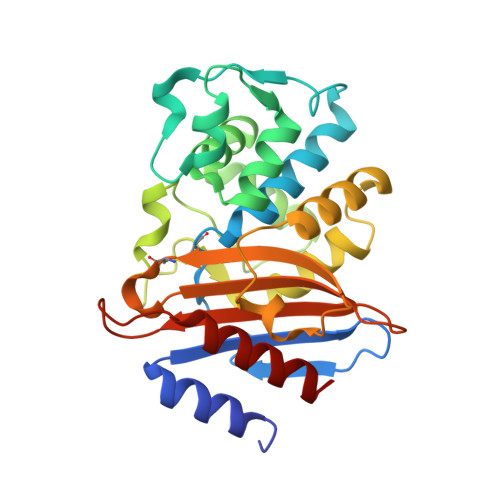Boronic Acid Transition State Inhibitors as Potent Inactivators of KPC and CTX-M beta-Lactamases: Biochemical and Structural Analyses.
Alsenani, T.A., Rodriguez, M.M., Ghiglione, B., Taracila, M.A., Mojica, M.F., Rojas, L.J., Hujer, A.M., Gutkind, G., Bethel, C.R., Rather, P.N., Introvigne, M.L., Prati, F., Caselli, E., Power, P., van den Akker, F., Bonomo, R.A.(2023) Antimicrob Agents Chemother 67: e0093022-e0093022
- PubMed: 36602311
- DOI: https://doi.org/10.1128/aac.00930-22
- Primary Citation of Related Structures:
7UTB - PubMed Abstract:
Design of novel β-lactamase inhibitors (BLIs) is one of the currently accepted strategies to combat the threat of cephalosporin and carbapenem resistance in Gram-negative bacteria. B oronic a cid t ransition s tate i nhibitors (BATSIs) are competitive, reversible BLIs that offer promise as novel therapeutic agents. In this study, the activities of two α-amido-β-triazolylethaneboronic acid transition state inhibitors (S02030 and MB_076) targeting representative KPC (KPC-2) and CTX-M (CTX-M-96, a CTX-M-15-type extended-spectrum β-lactamase [ESBL]) β-lactamases were evaluated. The 50% inhibitory concentrations (IC 50 s) for both inhibitors were measured in the nanomolar range (2 to 135 nM). For S02030, the k 2 / K for CTX-M-96 (24,000 M -1 s -1 ) was twice the reported value for KPC-2 (12,000 M -1 s -1 ); for MB_076, the k 2 / K values ranged from 1,200 M -1 s -1 (KPC-2) to 3,900 M -1 s -1 (CTX-M-96). Crystal structures of KPC-2 with MB_076 (1.38-Å resolution) and S02030 and the in silico models of CTX-M-96 with these two BATSIs show that interaction in the CTX-M-96-S02030 and CTX-M-96-MB_076 complexes were overall equivalent to that observed for the crystallographic structure of KPC-2-S02030 and KPC-2-MB_076. The tetrahedral interaction surrounding the boron atom from S02030 and MB_076 creates a favorable hydrogen bonding network with S70, S130, N132, N170, and S237. However, the changes from W105 in KPC-2 to Y105 in CTX-M-96 and the missing residue R220 in CTX-M-96 alter the arrangement of the inhibitors in the active site of CTX-M-96, partially explaining the difference in kinetic parameters. The novel BATSI scaffolds studied here advance our understanding of structure-activity relationships (SARs) and illustrate the importance of new approaches to β-lactamase inhibitor design.
- Department of Biochemistry, Case Western Reserve University School of Medicine, Cleveland, Ohio, USA.
Organizational Affiliation:

















